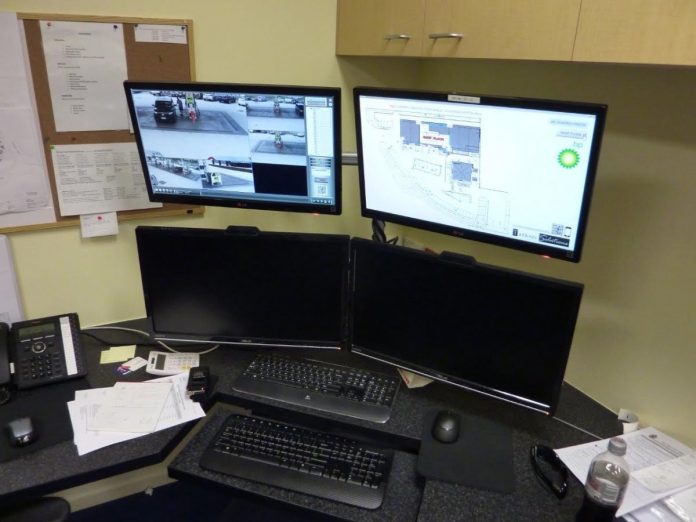Parramatta Council has completed Stage 1 of its CitySafe project, which includes a Milestone XProtect Corporate VMS managing Axis and Sony cameras supported by a blown-fibre backbone. The solution was designed by Tavcom, commissioned by Hills and installed by SNP.
WHEN I worked here in the late 1980s, Parramatta was a sleepy country town on a winding brown river, streets wide enough for horse teams and a sandstone past poking out of every corner – from Old Government House and tiny golden shop fronts, to broad-brimmed farm houses – and shimmering through this, the deeper history of Pemulwuy and the first Australians.
In 2015 that layered history remains but the city has changed. Parramatta hums with a commercial and social gravity that has ignited a process of accelerating and continuous growth. Arriving by car and following my nose towards the General Bourke Hotel, I immediately get lost between a cavernous bus station and a canyon of high rise and ducking frantically to the left, accidentally find a parking station.
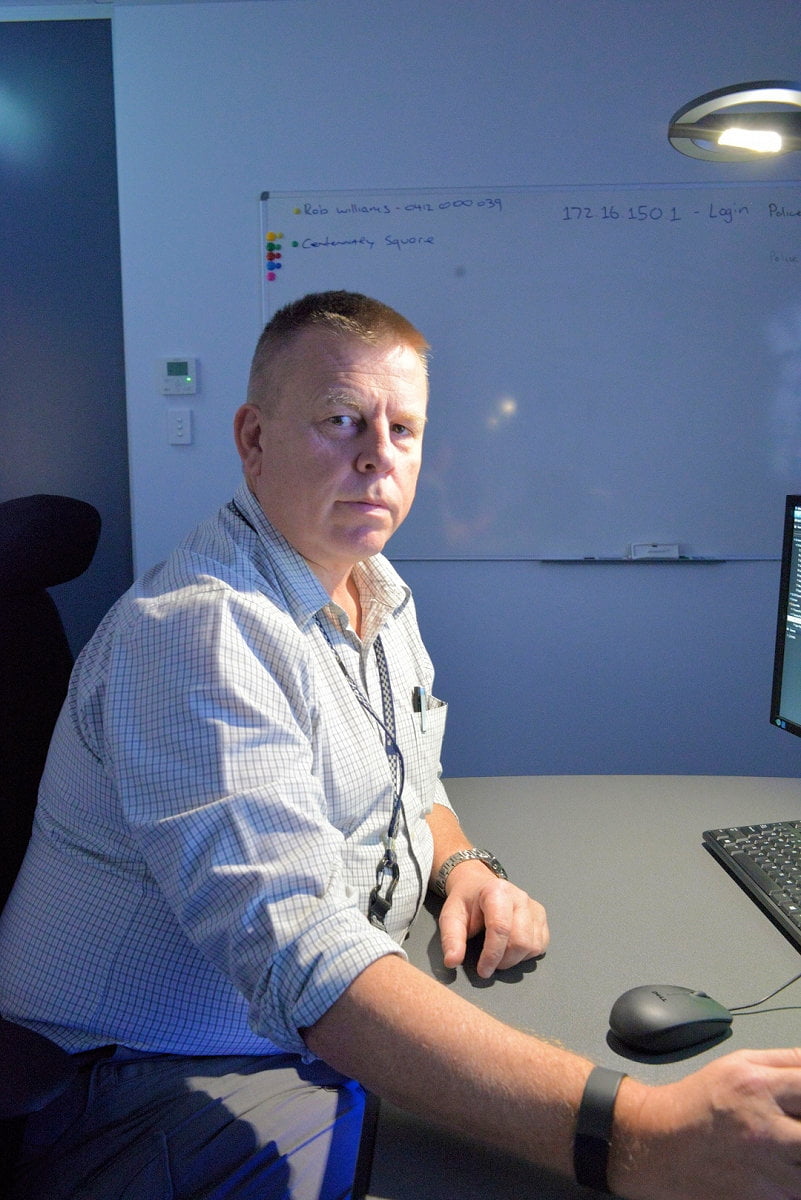
Rob Williams, Parramatta Council
My instinct and memory of the one-way streets and pedestrian mall here tells me finding Parramatta Council’s CitySafe Operations Centre is going to be easier on foot than on wheels. Later on when I’m listening to the story of the CCTV system unfolding, it occurs to me that everyone else feels the same way about Parramatta CBD. The geography and anthropology of foot traffic are key drivers of the CitySafe surveillance system’s design.
Showing me around the CitySafe system are Parramatta Council’s crime prevention officer Rob Williams and consultant Lee Evans from Tavcom. Throughout our conversation, Williams exhibits a strong operational focus, with an accent on technology. I get a sense that if a cutting edge solution could be shown to offer real benefits to the city, he’d be interested. Evans meanwhile, has a technical mind and conversations with him are drawn towards standards like iron filings to a strong magnet.
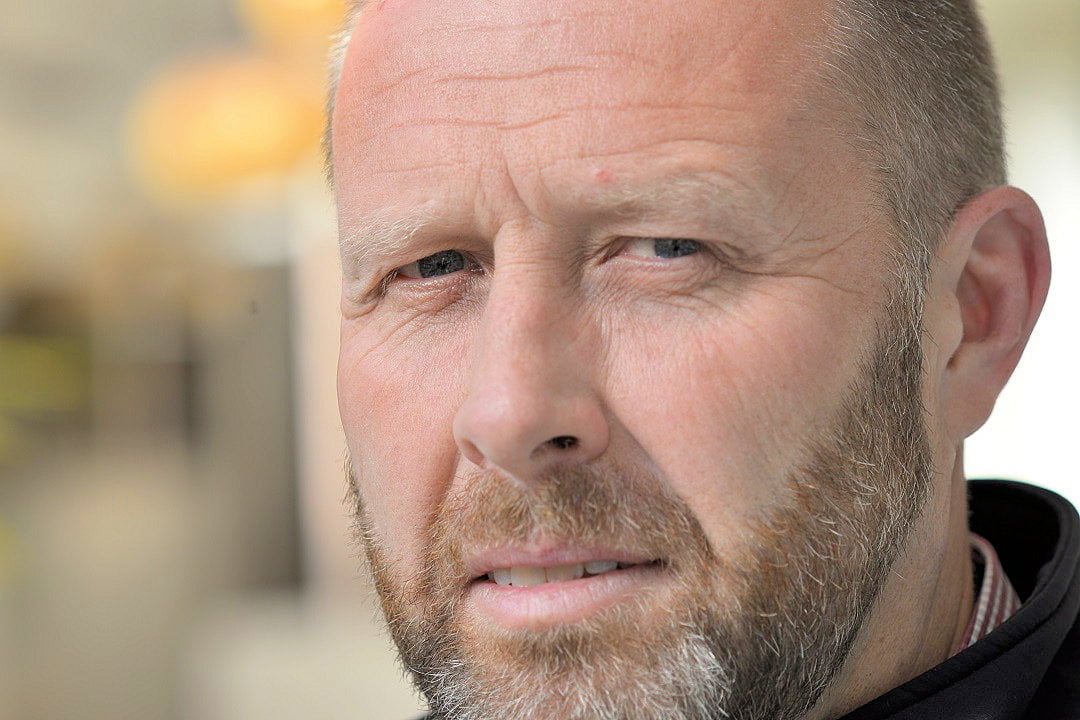
Lee Evans, Tavcom
The boys have worked together on this project system for a long time and have a mutual understanding of what CitySafe is meant to achieve now and in the future, sharing each other’s frustrations and sometimes finishing each other’s sentences as they explain system evolution and key challenges.
According to Williams, the evolutionary process of CitySafe means that it’s an expansion of an existing solution designed to support pointy operational requirements, not a greenfield solution installed to meet a narrow objective. But while there’s no over-arching CitySafe mission statement, the CCTV masterplan Williams and Evans are working on has an identifiable, plural nature.
CitySafe is designed to allow Council, with support from NSW Police, to ensure Parramatta CBD is safe and secure during major events when there’s very heavy foot traffic between big sporting and entertainment venues. Further, the system is able to view unfolding events in real time day and night, as well as providing detailed court admissible recorded evidence to police investigators. Finally, the CitySafe monitoring centre can be used by emergency services in real time for crisis management.
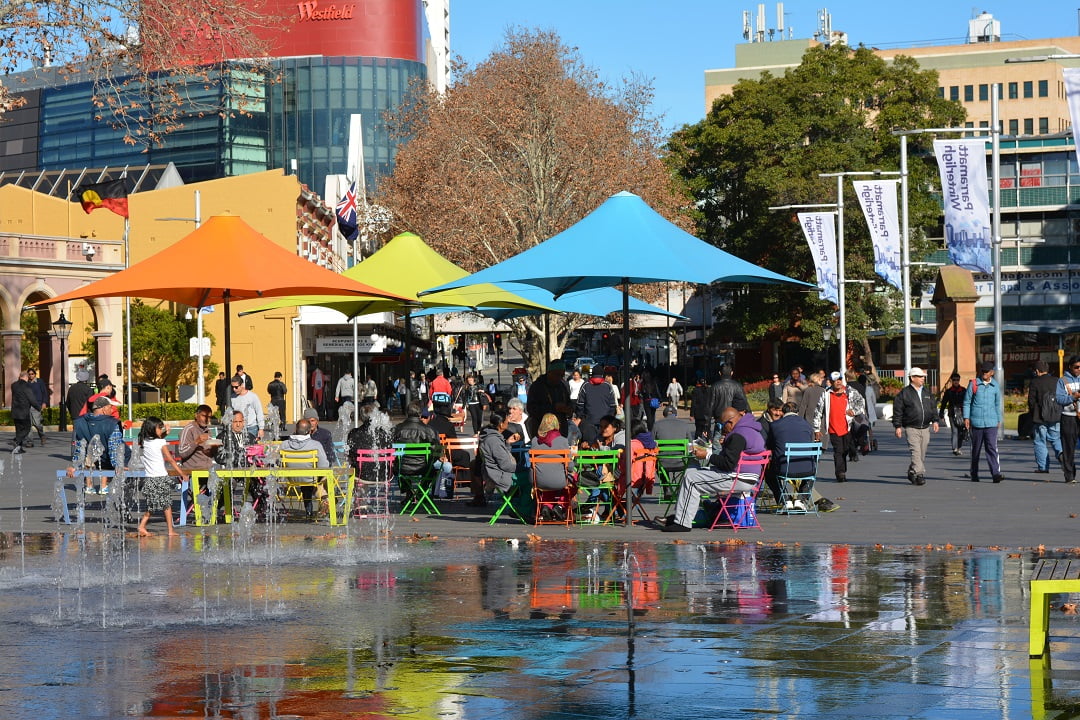
Looking up Centenary Square towards Parramatta Station
Williams points out that additional key aspects of the system were that Council could not be locked into a proprietary solution and wanted its infrastructure to allow CitySafe to grow in terms of bandwidth and camera numbers. Further, the system had to be capable of supporting remote sites.
History and planning
Like many things in Parramatta, getting a handle on CitySafe’s present means understanding the past. Williams joined Council in his current role back in 2009 and he says prior to this, Council operated a few security cameras giving a small amount of incidental public surveillance in Centenary Square, formerly Church St Mall.
“This was a hotspot for antisocial behaviour and there were a small number of cameras adjacent to this area,” Williams explains. “When I arrived there was no plan for expansion and not the necessary level of procedure in terms of who was monitoring the system, or managing the processes of getting images to police.
“Obviously, this was a concern to Council, which had looked at the issue of public space surveillance and had commissioned reports and debated the issue but discarded it due to cost and internal policies of the time,” he says. “When I arrived, I started a program of rapid deployment cameras in response to incidents around the CBD and that was the first real application of public surveillance in the Parramatta CBD.”
Those first rapid deployment units were solar powered Mobotix cameras built into self-contained units which take an hour to install and incorporate on-board storage and remote 3G accessibility.
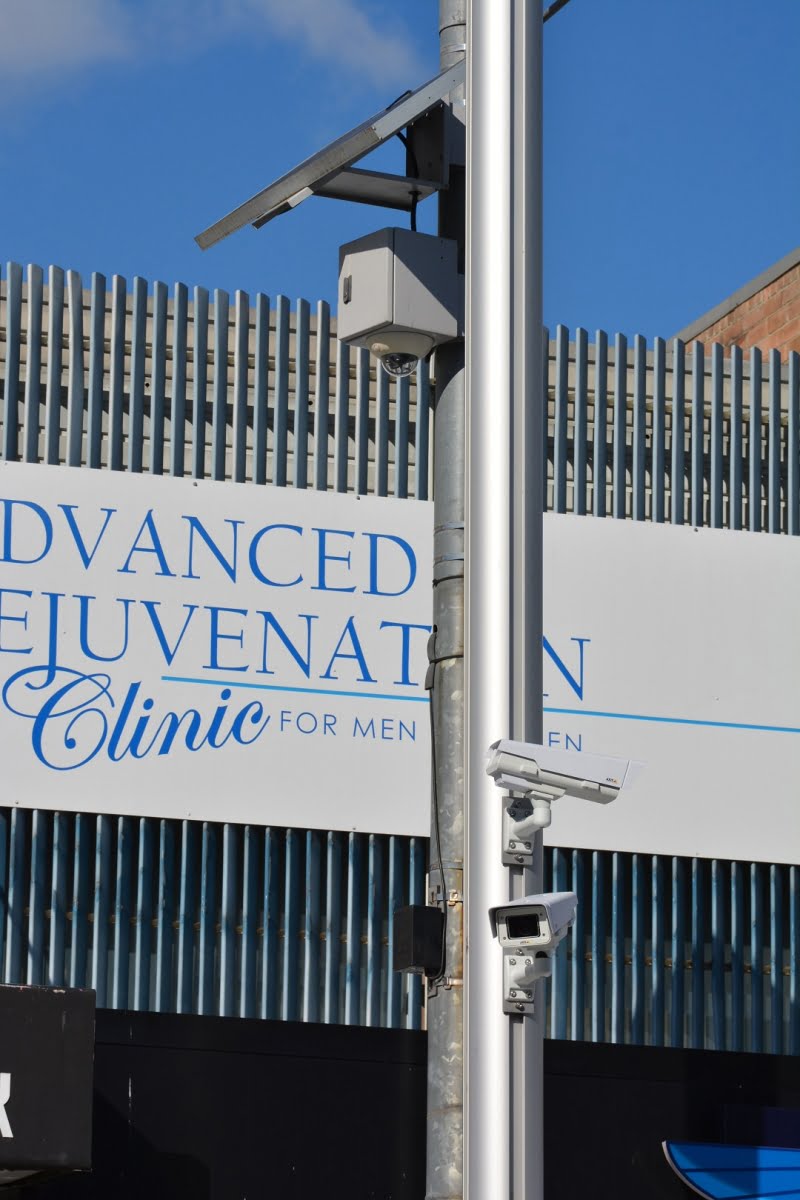
Mobotix-based mobile camera unit top, a pair of Axis fixed cameras below.
“We started with 4 of those rapid deployment cameras and they proved very successful for monitoring things like dumping and crime hotspots – we could move them around as we needed,” Williams says. “That rapid deployment surveillance program expanded and in the space of 5 years we’ve gone from 4 to 40 of those Mobotix cameras.”
But according to Williams, it was the success of the first rapid deployment cameras and the shape the mobile CCTV network took in response to events in the Parramatta CBD that informed his plans for a fixed CCTV solution.
“We found there were cameras we did not move – they were covering hotspots,” Williams says. “There are a couple of large sporting and entertainment venues in and around the Parramatta CBD that are widely spread out. At certain times we found large numbers of people moved between those venues on foot and we had trouble when some groups met. We were finding we needed coverage of those paths of movement more or less constantly.
“I put to council that if we were going to have a permanent installation, then solar-powered rapid deployment cameras were not the right solution,” says Williams. “Experience had shown us that over a period of days without sun, they’d power down and stop transmitting until their solar arrays recharged their batteries, which is perfect behaviour for a mobile camera, but not for a fixed camera in a busy CBD.”
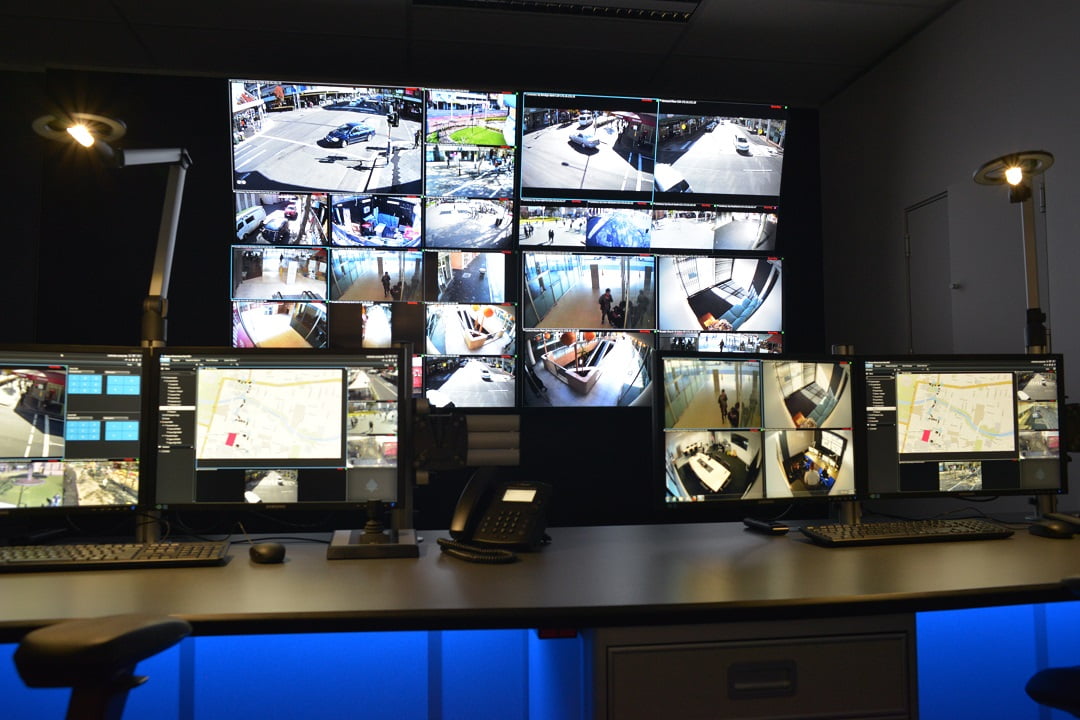
The CitySafe control room is nice work by Thinking Space.
After Williams had made his submission, he received funding from Council to develop a master plan for CCTV.
“Part of the research involved looking at other local government CCTV applications around Australia,” Williams says. “We then commissioned Chris Cubbage from Amlac House in WA as consultant and together developed our CCTV master plan around a wireless network in order to save on installation costs. Council allocated funds for Stage 1 and Stage 2 of the system and we received a Federal grant of $A1 million, under the Safer Streets program, which provided $A50m to Councils around Australia for CCTV, lighting and security infrastructure to get things moving.”
Stage 1
After funding was allocated, getting started on Stage 1 was not without its challenges.
“Initially we were engaged in discussions with a utility to share poles and power for our cameras and the receivers and transmitters of the planned wireless network,” explains Williams. “But there were technical limitations. We would have to run our own power and we were told we couldn’t drill into the poles – this made sharing poles unviable. We decided that given we had to do extensive trenching for power, it would be better to run fibre and provide a future-proof infrastructure.
“As a result, we have more than 2km of blown fibre in the CBD using a combination of open trenching and micro slotting, our own power supplies and when we put in cameras, we put in multi-function poles with LED lighting,” Williams says.
Blown fibre is a nice piece of infrastructure. Typically, when you lay conventional fibre you’d install a particular number of fibres and some dark fibre to cover projected future growth.
“With blown fibre it’s an empty 24-tube barrel,” explains Williams. “Once this is underground you blow a fibre into one of the 24 empty tubes when you need it – there’s no need to install dark fibres. Each tube in the barrel takes a 24-core OS1 fibre, so that’s a lot of potential bandwidth in the network. You can also suck a fibre out of blown fibre infrastructure as easily as you blew it in, so as technology improves, we can upgrade our fibre without needing to re-trench.”
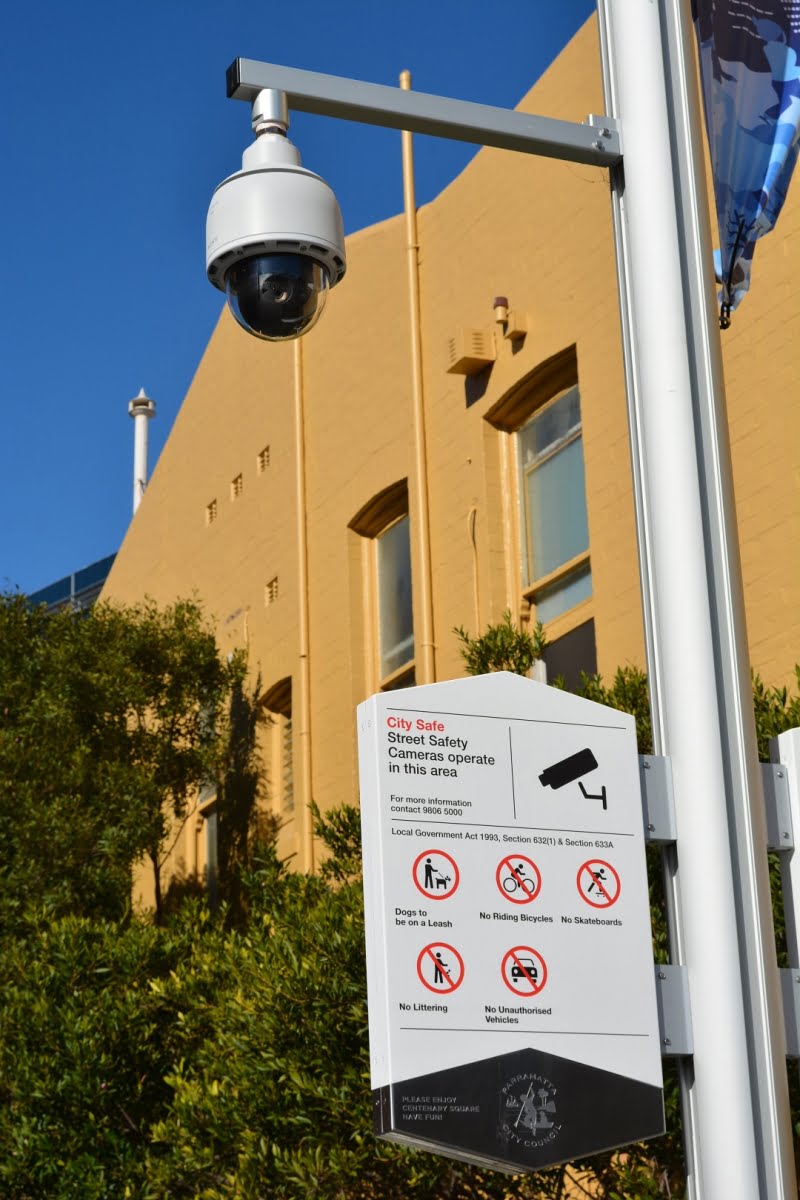
Sony’s 30x Gen 6 PTZ
The 2km blown fibre backbone supports 55 cameras – a mixture of Sony 6 Generation WR632 30x PTZs and Axis P1355 fixed cameras mounted on multi-function poles and supported by large IR arrays. Out in the field the cameras are supported by microsens switches, with a Gigabit Allied Telesis PoE switch at the heart of the system. Multiple workstations in the CitySafe control centre support Milestone Corporate VMS and the video wall.
“Our cameras are all 1080p running at 25 frames per second and we store images at full frame rate for 30 days in a 54TB array,” Williams says. “With 1080p resolution, we’d rather pay more for extra storage, which is now much less expensive, in order to get admissible evidence. Crimes in public spaces tend to be rapidly moving so when you get events like brawls and bag snatches you need high frame rate and good resolution in order to get incident continuity. Experience showed us that with fast moving incidents 16 frames per second was simply not high enough.
“We had an experience with a 16 frame per second rapid deployment camera in which only a single frame of our footage showed a knife in the offender’s hand because it was such a rapidly moving night time scene,” he says. “At 16 frames per second there’s a lot of gapping in fast moving scenes. Without that frame it would have been hard to prosecute and CCTV is something prosecutors really rely on and there’s an expectation from the public that there will be CCTV footage.”
According to Williams, it’s a false economy to spend millions of dollars on a CCTV system and then scrimp on storage so they system fails to give its best possible resolution and recording speed.
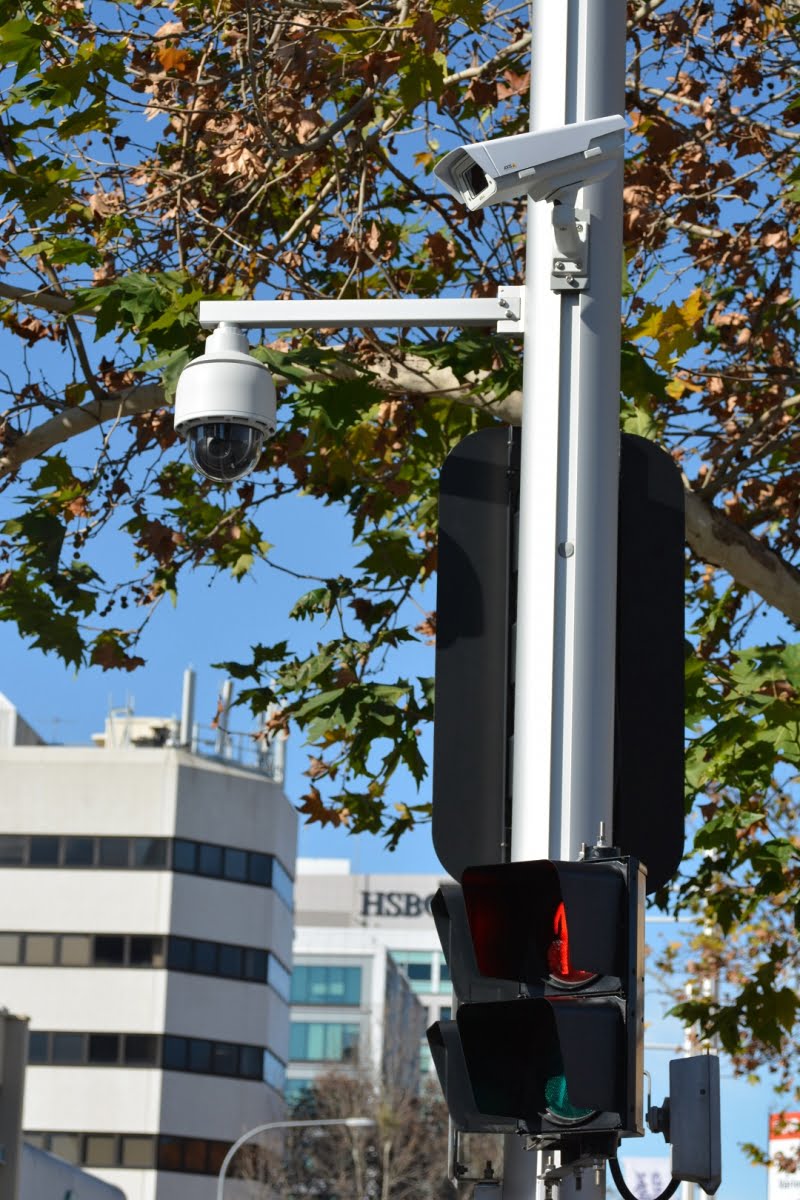
Interestingly, there’s more headroom in the storage department, according to Evans.
“We are actually getting more than 30 days recording from the system and that’s without using Axis Zipstream,” he says. “There may be even more benefits to be gained using that technology.”
In terms of camera coverage, Williams says cameras are installed at key locations that allow system operators to identify and follow people moving through the CBD.
“Sometimes while they are in the CBD people try to cover up their identity but because of the nature of our coverage we’ve already identified them on multiple cameras,” Williams says. “The camera network has been specifically set up to look at all the various choke points so that we will see people entering or leaving the CBD, the direction they leave in, as well as seeing where they go when moving through the city.”
Installation
Same as other major public surveillance applications, there are multiple interest groups in Parramatta and that has had an impact on lead time and the shape and nature of the installation. The actual construction took 12 months but according to Evans, planning started 12 months earlier.
“In terms of the process, Rob told me what he wanted and I wrote the specification, the fibre infrastructure was installed, TelstraSNP and then did the installation,” Evans explains. “But the actual process wasn’t as easy as that.”
Williams agrees.
“It’s been a rather dynamic project,” he says, smiling. “There’s so much development around Parramatta and this development – much of which we did not know about – impacted on what could be done and when. Many times we had to adjust our plans to take into account other projects. As a result, we’ve ended up with a system that’s different from the CCTV master plan, particularly on the river front, where we’ve chosen to wait until that project is completed before planning our network configuration.”
According to Williams, the issues during the build were almost all project issues though there were technical challenges in the early stages.
“The issues started with the shelved plan to share utility poles – this meant a significant change of technology – and expanded as other parts of Council’s plans for development in Parramatta constrained our CCTV master plan,” Williams says. “That was the biggest challenge. Finding our way around external pressures meant we were changing the project almost weekly and this went on for the first 6-9 months.”
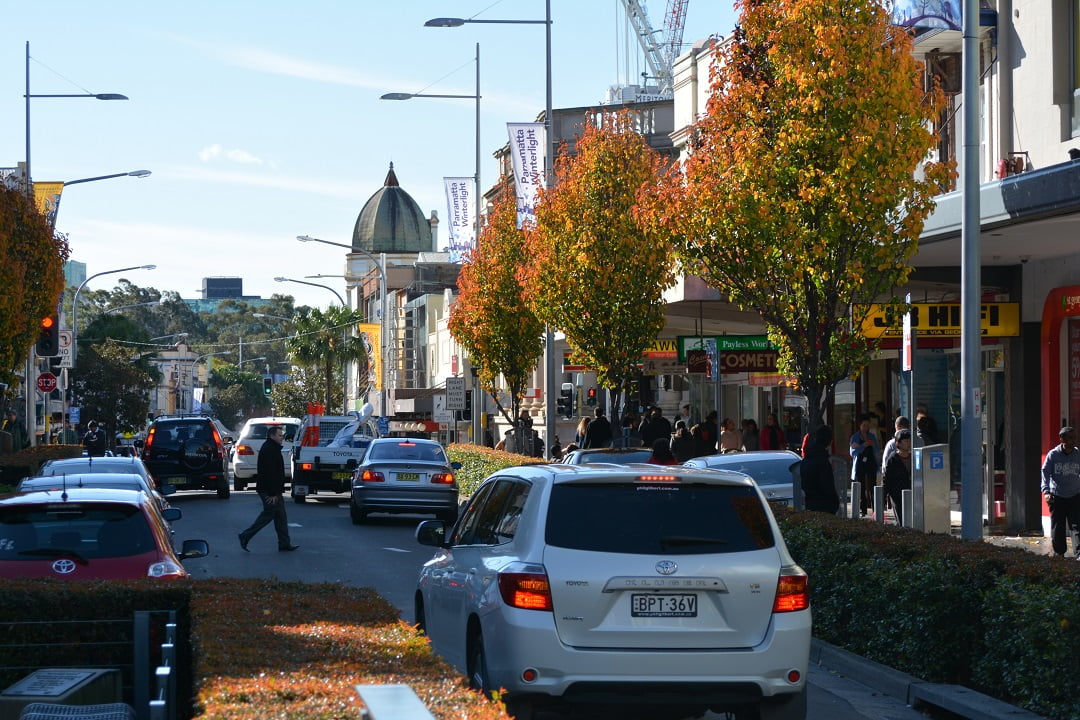
Unsurprisingly, Parramatta’s history kept intruding into the process.
“There were also challenges of construction,” Williams says. “You’d do all your investigation of a path for trenching and as soon as the digging started you’d find services under the ground were unexpected or undocumented. And there were archaeological issues, too. Original parts of roadways from early Parramatta had to be embedded in sand and covered over and the position of poles had to be moved – that happened 2 or 3 times. If we hit something archaeological we have to down tools and get appropriate departments and experts involved.”
Because of the historical nature of Parramatta and its importance to the Burramattagal people, there are areas including parkland near Prince Alfred Square that were considered to be too delicate to be negotiated by the system.
“This park has Aboriginal, historical and archaeological significance right down to some of the trees growing on it,” says Williams. “After consideration, we decided it would be easier and much faster to excavate along the footpath and go around it.”
According to Williams, now that Stage 1 is finish it will take another 12 months to finish Stage 2.
“But there are a lot of variables to take into account,” he says. “Obviously, we don’t need cameras everywhere in the city but there are areas that may be need more coverage, depending on evolving development plans. If the stadium precinct is redeveloped we will need to look at covering areas leading to that, for instance.
“It’s not about camera numbers but getting the right views,” Williams adds. “You can do more with 100 well placed cameras than 200 cameras that are poorly directed. And there comes a point when it’s impossible to watch hundreds of cameras effectively.
“From the point of view of design here, it’s about aligning coverage with pedestrian routes and centres of activity. At the moment we are along Church St, Macquarie St and George St and we may look to expanding to Charles St and Parramatta Park as part of Stage 2.”
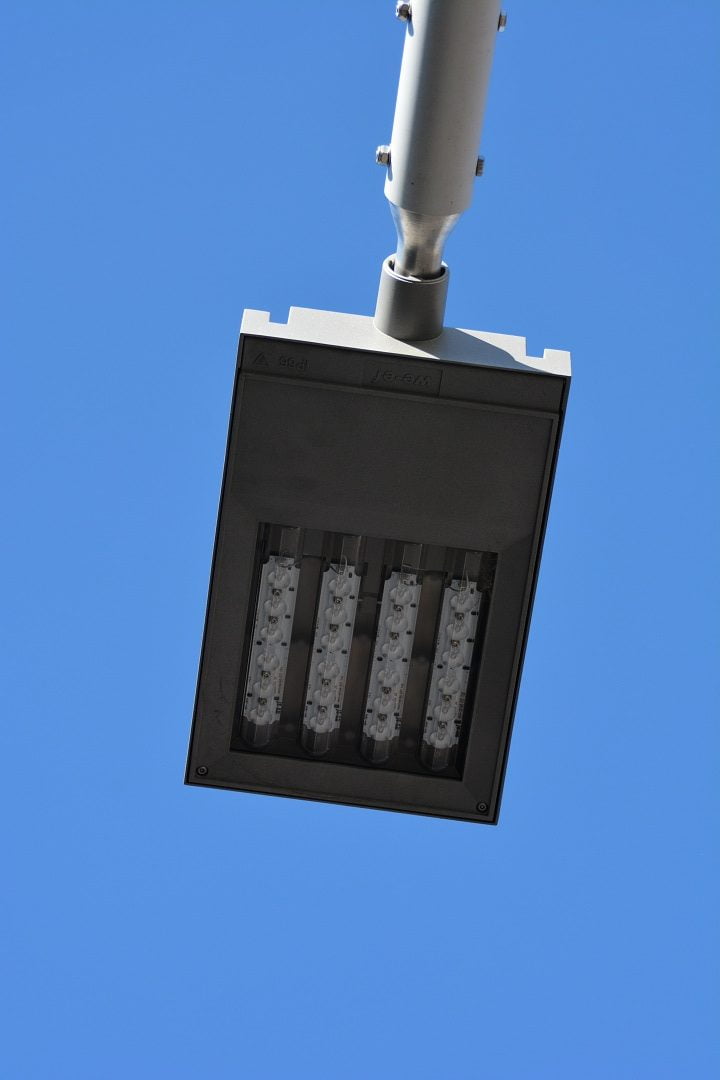
LED array on utility pole.
While there’s LED lighting in key locations on the poles, there are also areas where it’s darker that had to be managed during the install.
“There are some areas that are more challenging as well as areas where cameras go to black and white after hours,” Williams says. “But we’ve actually set the cameras to stay in colour and they work very well in low light. We want colour so as to be able to recognise attire as people move through the CBD.”
According to Evans, a quirk of the installation is that the heart of the system is Town Hall, not the CitySafe control centre as might be expected.
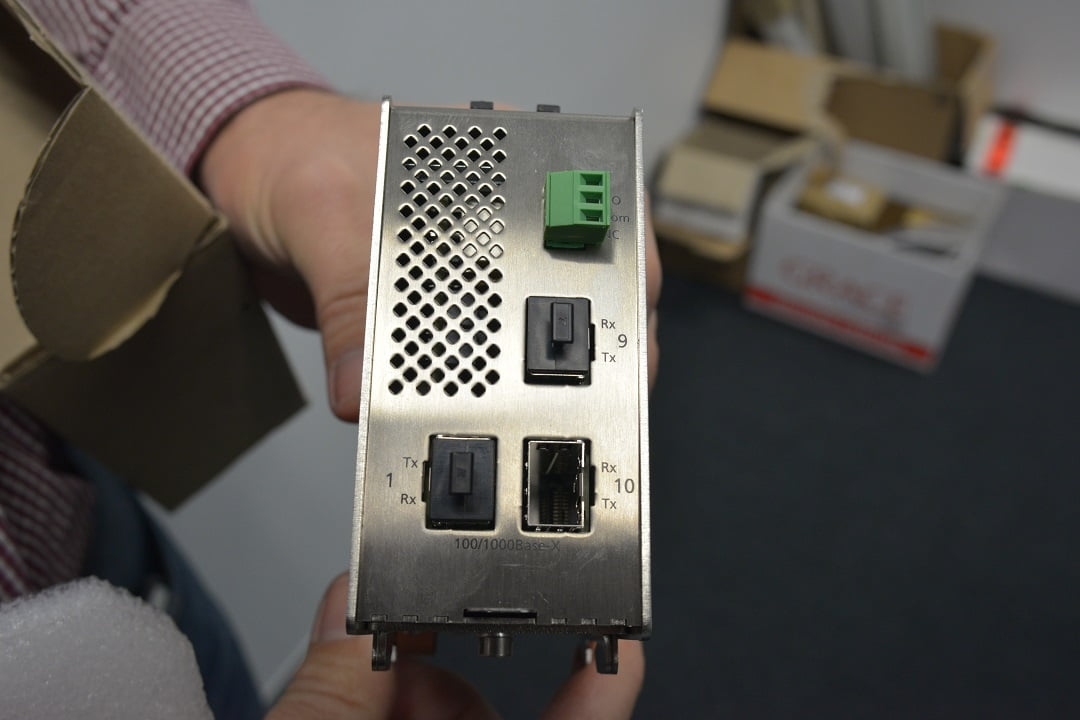
Gigbit field switch
“Because the redevelopment of Parramatta Square and the new Council building will see widespread demolition of existing buildings, all the fibres come into Town Hall, which is one of the few structures that will remain,” he says. “That was deliberate as we wanted to get close as possible to Parramatta Square. The way it works at the moment is that a pair of fibres come from Town Hall to a patch panel in the rack in the network room behind this control room, to a switch, to servers and to video walls and workstations in the control room.”
When it comes to technical challenges of the installation, Evans says these related to changing comms technologies and getting the go-ahead on slot trenching, which was an unfamiliar technology to Council.
“We also chose to go with slot trenching for the final part of the works to the new Council office – it’s less invasive and less expensive. Basically it’s a saw-cut with the blown fibre cable laid into a cut that’s filled with bitumen all by a single machine,” he says. “This micro trenching allowed us to get the network from one side of the railway line to the other with a minimum of fuss and disruption to the CBD. Now it’s been done, Council is delighted with it but it was a process to get everyone on board with that concept.”
In terms of setting up the system proper, Evans says that was an easy process from his end.
“Hills has a good bench facility at Lidcombe and they pre-programmed and commissioned everything to our specifications for SNP to install,” he explains. “We simply inspected and signed off on the commissioned system before it was delivered to SNP.”
The control room
Before we take a walk around the CBD, we spend some time in the control room itself. The monitoring room is nicely laid out – Thinking Space supplied the hardware – desks, chairs and racks fitted with monitors and a compact video wall. From a comms perspective, the monitoring centre is stand-alone and separate from the Council systems on its own subnet. If you want into the network, you have to come to the control room.
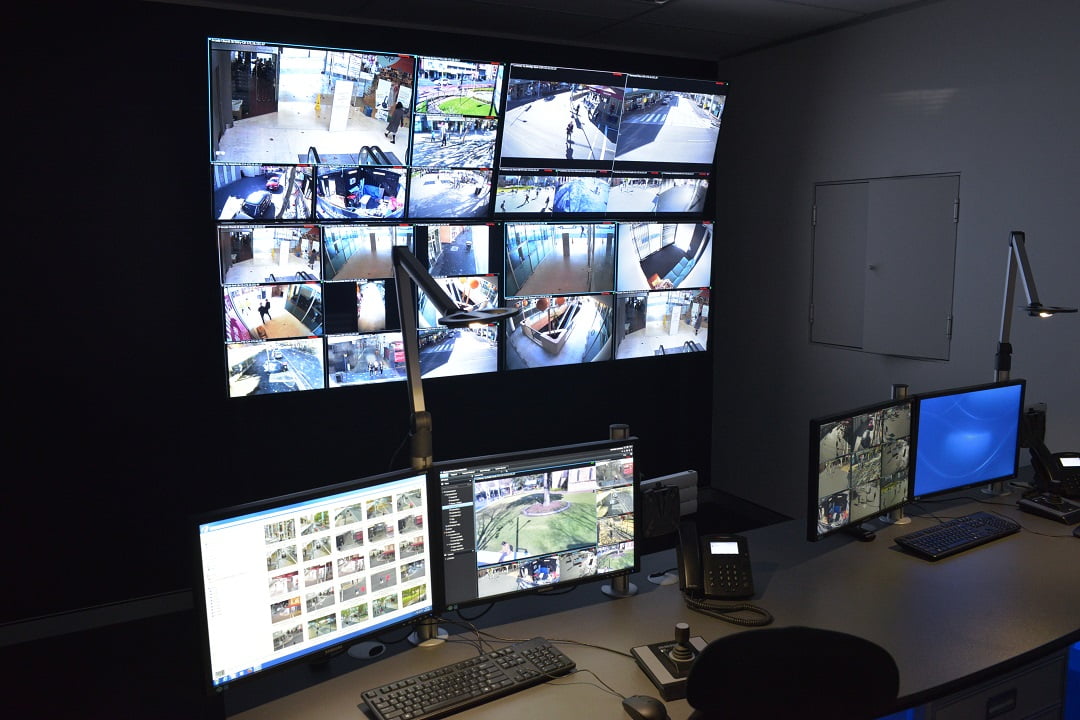
CitySafe Control room.
The room has a nice atmosphere, there are big desks outside to facilitate crisis management and access to the room is via a proper man-trap. Everything is sensibly laid out and conforms to appropriate standards at every turn. The network room is adjacent to the control room on the sterile side, which is great from a security perspective. The network room, too, is well done, with no stray cabling or mess outside the locked racks.
“This monitoring centre is manned during peak periods and it is planned this will be staffed full-time as the system expands over a 4-5 year timeline,” explains Williams. “It works well with the number of cameras we currently have. If you look at the way crime works in a city, it’s more prevalent in the summer in good weather, around major events. For that reason, we won’t be monitoring 24×7 initially but that will change over time.”
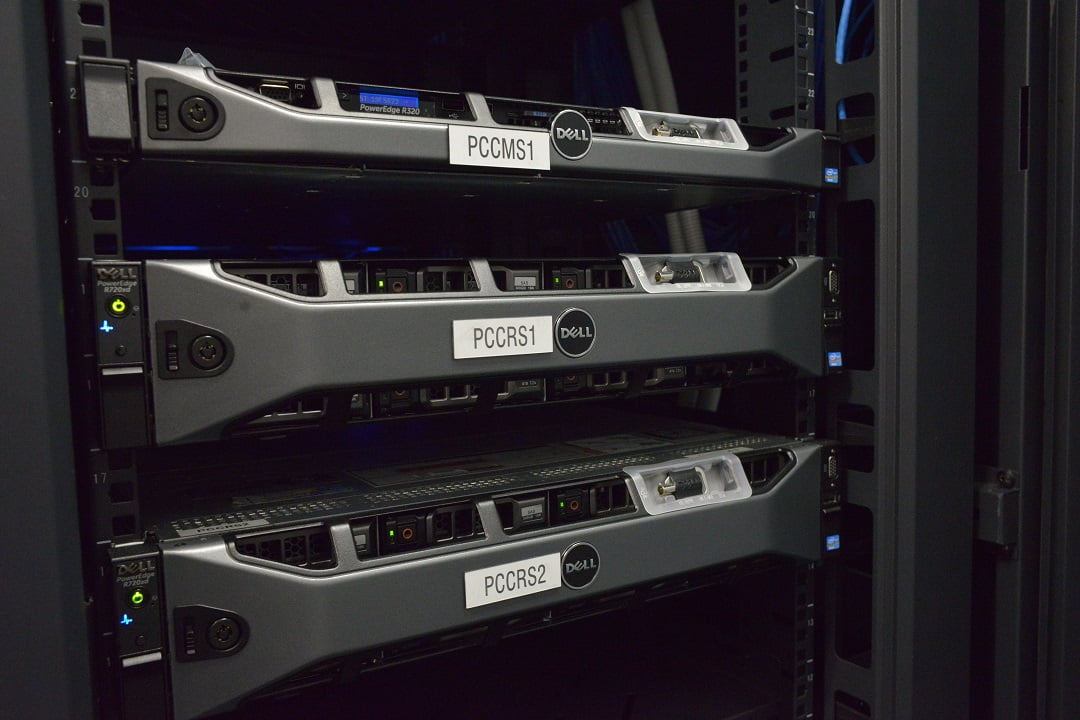
Dell servers are running the Milestone software.
Highlighting the evolving nature of the system and Parramatta CBD, this monitoring centre will move in October to a space in a nearby building and will then move yet again when Parramatta Square is completed.
“Everything along Darcy St will be demolished to make way for Parramatta Square – a new Council building will be built and in that new building there will be a new monitoring centre very similar to this one – that’s probably 4 years away,” Williams explains.
When manned this monitoring centre is phone or radio-linked to local police officers depending on the nature of the event being covered.
“In such instances we work closely with police to support them with CCTV monitoring and that partnership is obviously an ongoing consideration of our CCTV master plan,” Williams says.
Now Williams drives the system to show the nature of the CitySafe solution and the capability of the Sony PTZs and it gives me another opportunity to take a look at the performance of the Milestone XProtect Smart Client which is the front end of XProtect Corporate and its integrated smart wall functionality. XProtect is a good solution, simple to operate and with a collection of capabilities that make it ideal for public surveillance applications. Importantly, this VMS has been modified to meet the demands of Council operators – there are maps with camera directions depicted via click-through icon.
In terms of network hardware, there’s one PC per workstation and one PC per video wall screen – but the boys manage to strain the system into latency when steering the PTZs, suggesting a workstation processor upgrade might be in order to handle the demands of the 55 full resolution, full frame rate image streams.
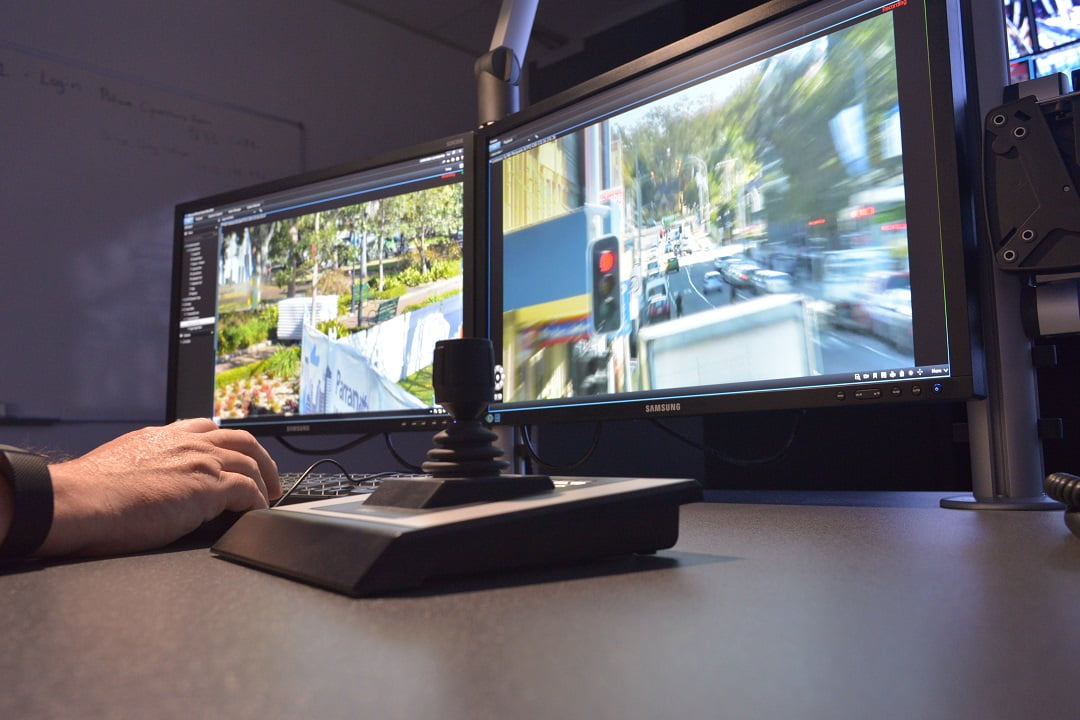
Zoooooooooom…
The Axis fixed cameras are solid in their own right day and night but as soon as Williams grabs the joystick and peers 2 city blocks with the Sony PTZ you tend to forget about everything else. The PTZ cameras are sited so they can get the longest possible views in the most possible directions and with such deep street scenes you can see how a 30x PTZ gives operators profound real time capabilities to monitor unfolding events.
With the Sony PTZ the field of view is narrower than the fixed cameras but it’s distortion-free and snaffles face recognition deep into scenes – right at the limit of sensible viewing 250-300m there’s valuable layers of detail. What’s really impressive is the zoomed depth of field. PTZs typically have the best CCTV camera optics in my opinion, and it’s really noticeable when you are getting valuable depths of field of 40-50m even when zoomed halfway through a scene, with excellent sharpness, colour and contrast. We get nice snapshots and can identify faces, clothing, even tattoos, in great detail from considerable distances.
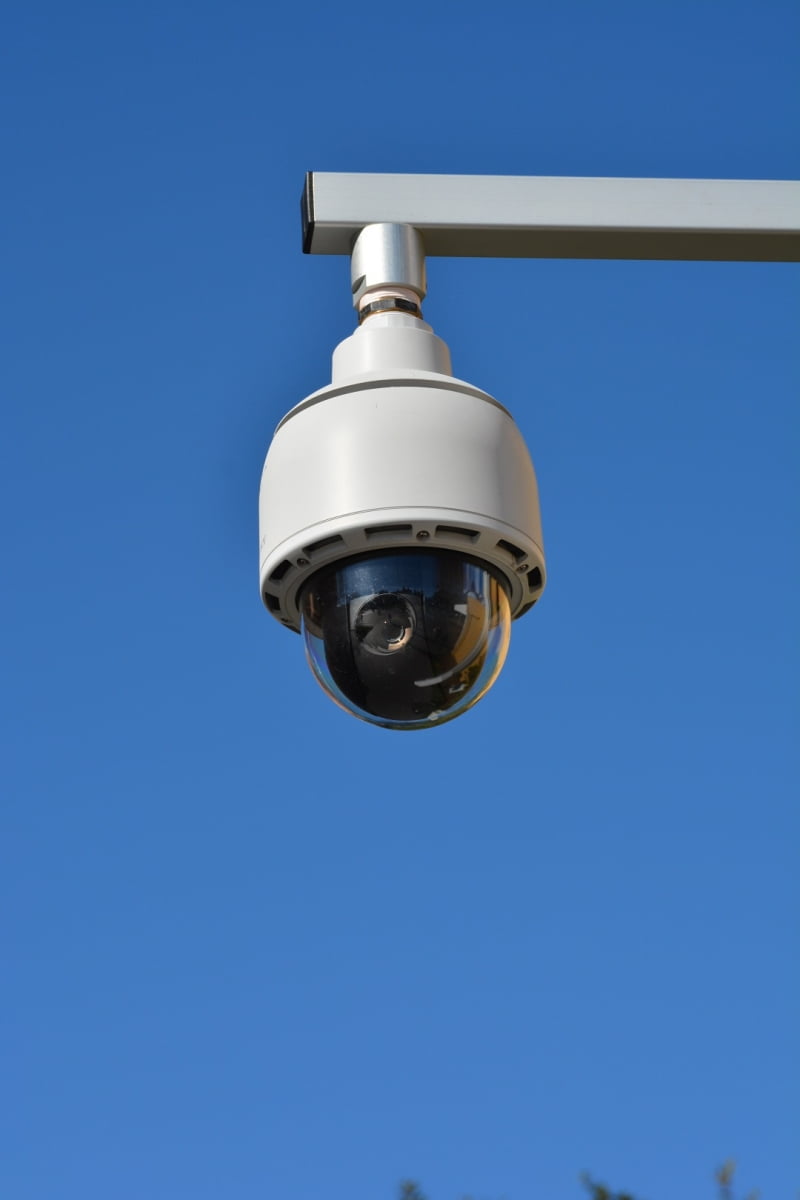
We also look at footage from the fixed Axis camera of an incident that occurred in the past and the coverage and quality are easily sufficient to support police investigating that crime. It’s the sort of footage that comes from a well-designed system using quality components. These cameras aren’t facing in precisely the right direction to capture faces in an open public space accidentally. The Axis fixed cameras do the job well. There’s a wide angle view, good depth of field, good colour, and the combination of ambient light and LED light is sufficient to give nice images in colour at night.
“I’m very pleased with the 30x optical zoom on the Sony PTZs – I can see all the way from the Mission on Macquarie St down to Parramatta Park – 250-300m away – and read a license plate – that’s how good they are,” Williams says.
To prove the point he steers a PTZ down Macquarie and yes, licence plates – and near court admissible face recognition, too – even on a very windy day with a lot of pole shake.
“In tighter scenes our Axis fixed cameras are great,” Williams says. “But for longer scenes, I think with 1080p resolution, having an optical zoom is advantageous, especially in an application like this one with such long street views. You simply can’t zoom into a 1080p image without rapid degradation of the image quality but with 30x optical you can get full resolution images all the way through the focal length of the camera.
“PTZs work best when handled in real time but outside those times you can schedule home positions to change at different times of the day or week, which is a great help. The other thing I like is that you can’t be certain whether they are facing until you get to the camera – that’s a deterrent.”
Walking the system
Next, I take a walk through the CBD with Evans. Parramatta CBD is built on river flats and the roads are straight and long, laid out grid-like between Parramatta Station and Parramatta River. One of the things that’s most noticeable when walking the system is its geographical size. Even for a public surveillance system, CitySafe is big and the reason Williams and Evans went with 30x PTZs quickly becomes clear.
We take a look at the camera poles and their LED arrays. Each of the poles has a fixed camera, a PTZ and an IR panel on it. The work is tidy and the pole locations are thoughtful. Good too, are clear signs that proclaim the presence of the CitySafe system. I also get a look at the Mobotix rapid deployment cameras with their solar panels, which are all still a vital and flexible part of the system.
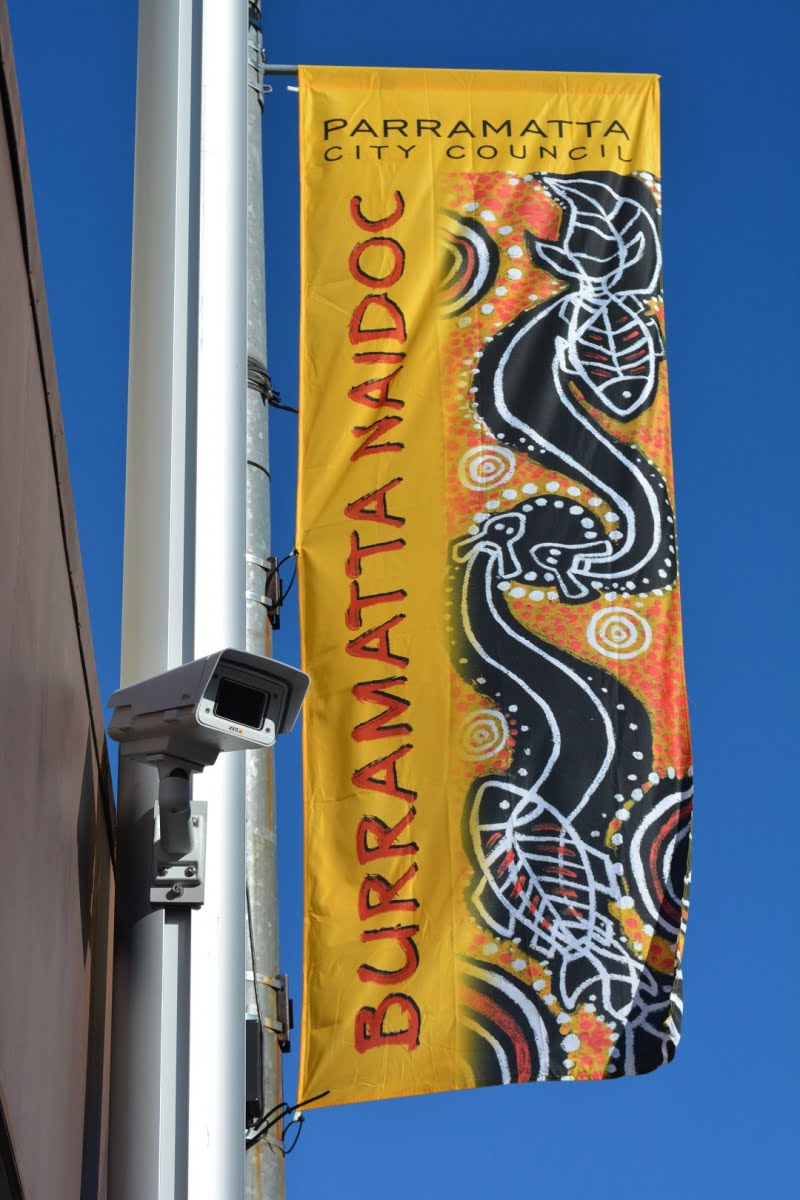
It’s a nice place Parramatta, I think as we press forward into a howling westerly gale. There’s a lot happening, plenty of bustle and oceans of people. Something that’s noticeable is the cranes on the skyline along the river. You really do get a sense it’s all happening here and the plans show there’s plenty more to come. We walk all the way down from Centenary Square, across Parramatta River where cameras monitor the walkways in both directions.
As we walk, Evans explains that the fibre comes down Church Street, picks up this remote group of cameras and then heads off around Parramatta Park.
“The installation will be more comprehensive along the river in the future but because of the planned redevelopment here, that part of the installation is delayed until redevelopment plans are finalised,” he explains.
The plans are big. The Lennox Bridge Car Park is currently being transformed into the Lidis Riverside Tower development. This huge development will include ground floor river-facing cafes, restaurants and bars; a Council-owned exhibition centre, a 1000-seat conference centre, a residential tower with 37 stories of apartments, and adjacent to this, a public domain upgrade of the foreshore, including new pedestrian links and cycle paths. Taken as a whole, Parramatta is in the midst of a vast urban transformation.

Development along Parramatta River
On our way back, Evans points out the choke points, street corners that act as portals to carry foot traffic onto central streets that funnel pedestrians from the outer parts of the CBD towards Centenary Square and Parramatta Station. Finally, we have a look at the micro trenching under the railway overpass. It’s surgical and I can easily see the attraction of slot trenching from the point of view of Council – a single machine cuts, lays blown fibre pipe, then fills the few-inch wide trench.
Plans for the future
Typically, plans for the future of a public surveillance system are modular – a new camera here, another camera over there. Parramatta is a different animal. The system is not only going to grow in the CBD, it’s going to bring in satellite town centres as well. How many? That depends on many things, including the possibility of Council amalgamation, which could see Parramatta Council grow to regional size.
“When Parramatta Square is built and that will bring in another 50 cameras,” says Williams. “And there are multiple other major developments in Parramatta – including the entire Parramatta Stadium precinct. These will increase the number of visitors, residents and workers and that will lead to greater demand for surveillance in the CBD.
According to Williams, Stage 2 of CitySafe is an expansion of the footprint in the Parramatta CBD as well as an expansion of the system to Westmead, Harris Park and Granville town centres.
“Once we’re done with that, we’ll then look at how to incorporate existing council infrastructure at remote locations – currently these go to local DVRs and are not networked to monitoring centre but ultimately they will be.”
Getting to these remote locations throws up new challenges.
“The idea is to use micro trenching to get to Harris Park but there are also negotiations with internet pioneer AARNET, which may lead to a potential partnership that will result in mutual cost savings,” says Evans. “AARNET needs to get into the CBD and we have spare fibre infrastructure that will allow them to do this. We need to get to Westmead, and they have dark fibre we can use to get to Westmead.
“That may happen next year and the wait has delayed us but it’s also been a valuable learning process for Council. What is happening now is that every time there’s work on roads and footpaths, conduits are being put in – all the project managers are talking to each other.”
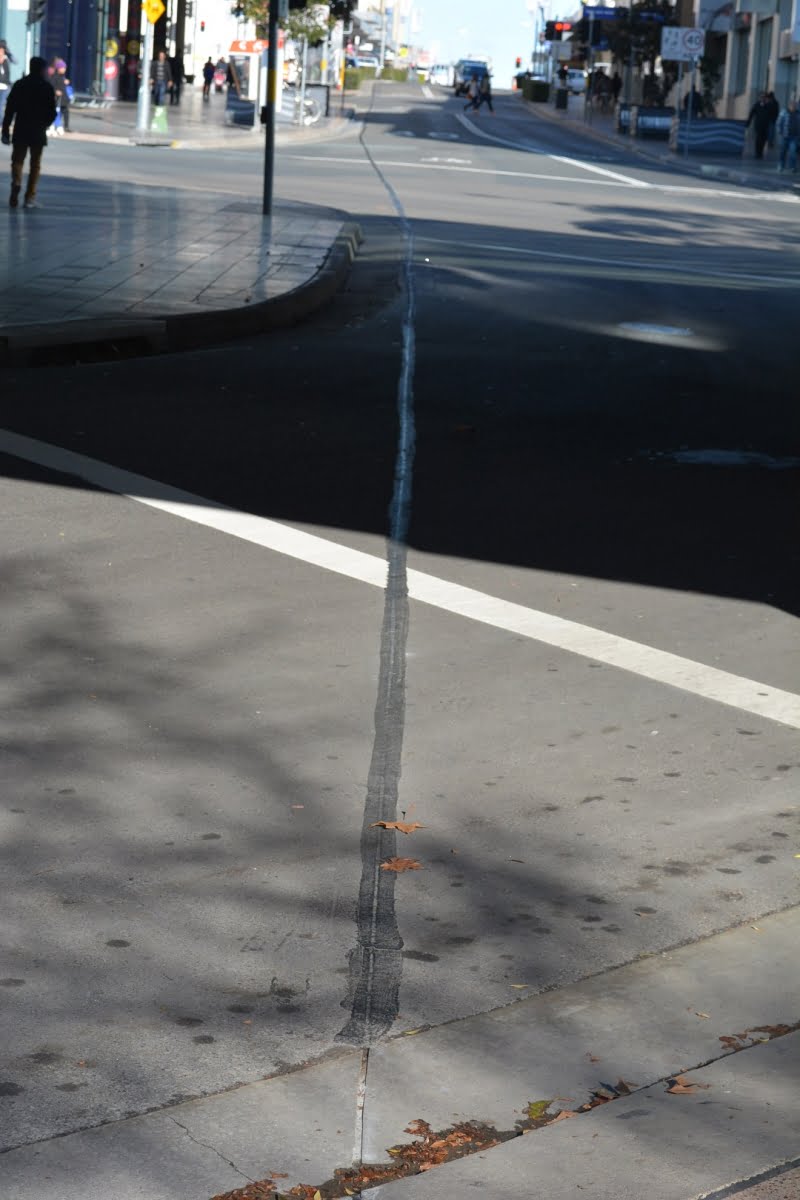
Micro slot trenching
In terms of integration, Williams says there may be integration with access control at Parramatta Square and the new Council building but that’s down the track – perhaps literally.
“Because of all the development we are also looking at a light rail system for Parramatta and that may mean a combined operations centre,” Williams says. “When the light rail comes in there will certainly be a need for transport monitoring and we may look at bringing in security and city management functions in the new Council facility.”
When it comes to technology, Williams says he’s interested in IVA but not 4K just yet.
“We are looking at IVA right now – we’d like to be able to look for distinguishing features – all the people with a white shirt moving in a particular direction on a particular day,” he explains. “But we want IVA that offers us actual performance capabilities, so we’ll take our time before committing to this decision.
“When it comes to 4K, I think there’s currently too much impact on the cost of storage and bandwidth – companies that rush into 4K are likely to wind those cameras back to lower resolutions or lower frame rates. It’s challenging enough to run 1080p at full frame and full resolution – we’ll look at 4K in the future.”
Conclusion
Looking at the system through an observer’s eye, it seems Parramatta Council had a clear idea of what it wanted to do and sufficient budget to install the best possible and most future-proof infrastructure. Everything about this system from the network room to the control centre to the poles and cameras in the field is a credit to those involved. But the crown jewel of CitySafe is what you don’t see – 24 barrels of buried blown fibre infrastructure, each barrel capable of holding a single 24-core fibre.
Williams’ operational focus means he sees the CitySafe surveillance system as a tool allowing police and the courts to prosecute anti-social behaviour of people moving through the CBD. Ultimately, this is the right way to look at public surveillance systems. A quality solution, well supported by operators, police and the courts, becomes a powerful driver of human behaviour, encouraging social behaviour and discouraging anti-social behaviour.
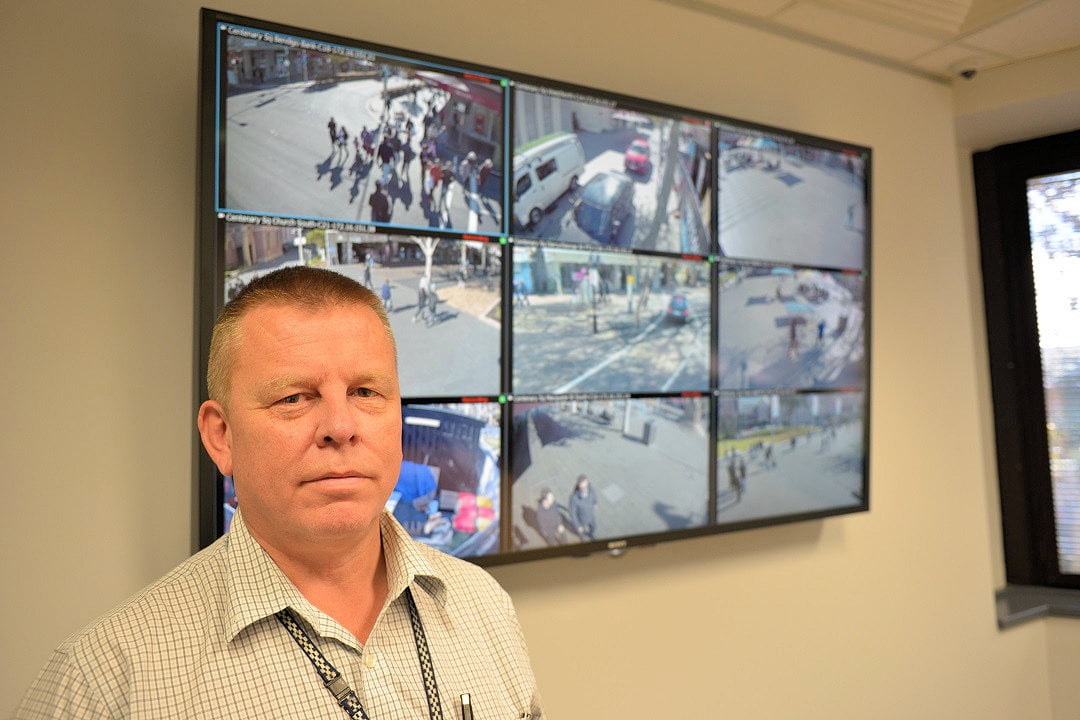
Rob Williams in the emergency operations room
“Parramatta suffers from reputation – it’s a city, so you get people coming in, there are government services, including the courts, it’s a transport hub, but statistically it’s much safer in Parramatta than in the City of Sydney,” Williams says.
“Over the next 5 years Parramatta will completely change as hundreds of billions of dollars are invested in the CBD. There are many new buildings planned – Meriton apartments, a new convention centre is about to break ground, there’s an expansion of a vibrant restaurant strip. Parramatta Square is the single biggest urban redevelopment in NSW after Barrangaroo and the University of Western Sydney is locked into PS1 – the first stage of Parramatta Square, with another big tenant soon to ne announced.
“Council is doing a lot in terms of crime prevention and application of safe city strategies as the city continues to change,” Williams says. “Parramatta is business friendly in terms of affordability and access thank to ease of commuting with major parking facilities, Parramatta Station and the planned light rail. There are many appealing things about Parramatta and CitySafe is one of them.”
By John Adams




